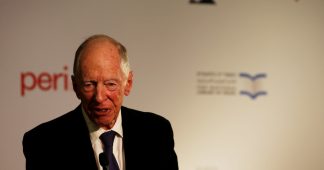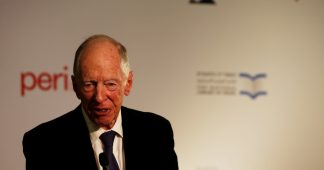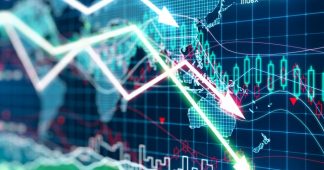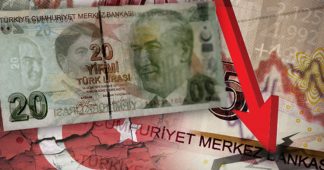3 April, 2020
In March, as Europe and the US began to apprehend the scale of the Covid-19 pandemic, investors panicked. Financial markets plunged. The rout was so severe that on several occasions in the second and third week of March, normal market functioning was in question. The prices of US Treasuries, the ultimate safe asset for investors all over the world, swung wildly as fund managers, scrambling for cash, sold everything they could sell. In the foreign exchange market, through which more than $6 trillion normally swirl every day, the traffic was all one way: out of every currency in the world, into dollars. No market can function for long like that. Sterling plunged. Even gold was sold off. This was not a banking crisis like the one in 2008, but, had it not been for the spectacular intervention carried out by the US Federal Reserve, the Bank of England and the European Central Bank, we would now be facing not only the ravages of Covid-19 and the disastrous social and economic consequences of the lockdown, but a financial heart attack as well. Instead, we are experiencing a shockwave of credit contraction. Production and employment have shrunk dramatically. Huge programmes of government spending have been set in motion, not to create new jobs but to sustain the economy on life-support. The challenge isn’t merely technical. This is a global crisis, which affects virtually every community on the planet. And it has exposed stark differences between the major economic blocs, such that it is now more difficult than ever to understand how the thing we call the world economy actually fits together.
The three great centres of production, exchange and corporate activity are the US, China and the Eurozone. These economic hubs are tied together through flows of trade, organised through complex supply chains that span the globe. Each of the three hubs has a hinterland extending into neighbouring regions in Latin America, East Central Europe, Africa and across Asia. They are all stitched into a global financial system that uses the US dollar as its currency of trade and credit. Each of the three hubs has characteristic weaknesses. The worry about China is the sustainability of its debt-fuelled economic growth. The basic weaknesses of the Eurozone are that it still doesn’t have a backstop for its rickety banking system and that it lacks a shared fiscal capacity; what’s more, Italy’s finances are so weak that they continually threaten to upset European solidarity. In the US, the national institutions of economic policy actually work: they demonstrated this in 2008 and are doing so again now. The Fed and the Treasury exert a huge influence not only over the US economy but the entire global system. The question is how they stand in relation to a profoundly divided American society and how their technocratic style of policymaking is received by the know-nothing nationalist right wing of the Republican Party and its champion in the White House.
Over recent years, each of these weaknesses has at various times seized the attention of the fund managers and business leaders who direct global business, and the experts and technicians who advise them. It isn’t a secret that China’s debt bubble, Europe’s divisions and America’s irrational political culture pose a challenge to the functioning of what we know as the world economy. What caused the panic last month was the realisation that Covid-19 has exposed all three weaknesses simultaneously. Indeed, in Europe and the US the failure of government has been so severe that we now face a public health catastrophe and an economic disaster at the same time. And to make matters worse, Donald Trump appears tempted to juggle the two.
Since 2008, the world economy has come to depend to a disconcerting degree on government stimulus. No one can pretend that our reality bears much resemblance to the pristine market models so popular in the 1980s and 1990s. But anyone who took those at face value was missing the point. All along, the state was actually involved, whether as a creator of markets, or as a distributor and enforcer of property rights. What is new is that the central banks are now permanently on call, adding further stimulus whenever growth flags. And they have been called on regularly because productivity growth has been so slow. At the same time, in an age of austerity, we have not been able to count on politicians to deliver adequate fiscal stimulus. The EU has until the current moment been deaf to any calls to loosen the purse strings. The Republicans play political football with the American budget. Only Beijing appears to hold all the strings – industrial policy, fiscal and monetary stimulus – in its hands.
The continuous injection of monetary stimulus by central banks confers differing degrees of profit and risk on its very unequal beneficiaries. In the US and Europe after 2008 stock markets roared ahead of earned incomes, exacerbating inequality. All over the world businesses borrowed in dollars, taking advantage of America’s deep financial markets and low interest rates. But that exposed them to risks. The first shock came in 2013 – the so-called ‘taper tantrum’ triggered by the Fed chair Ben Bernanke’s suggestion that America’s central bank might be about to take its foot off the accelerator. For many emerging markets 2013 was the point when growth slowed and their currencies began to lose ground.
In 2014 oil producers were hit by the first big slump in energy prices. Oil prices restabilised only in 2016, after Opec and Russia reached an uneasy agreement. Before that deal could be put in place, the world economy weathered the first real setback to China’s recent run of economic success. In 2015 the Shanghai stock market plunged and a trillion dollars fled China, depleting its immense reserves by a quarter. At the same moment the Eurozone was racked by its struggle with the left-wing government in Greece. This time not only the Chinese but the ECB as well reacted with a massive monetary stimulus. This delivered support to their economies, but because the Fed was beginning to edge up US interest rates precisely as the Europeans, Japanese and Chinese were adding stimulus, the effect was to cause the dollar to appreciate. This exerted pressure on those businesses and governments round the world that had taken up dollar credits, which now cost more in their local currencies. For the same reason a strong US dollar was also bad for US exporters. The mini-recession in US manufacturing that hit industrial regions like Michigan and Wisconsin was an underappreciated factor in setting the stage for Trump’s surprise victory in 2016.
When Trump took over the White House in January 2017 there was anxious talk about the threat of populism. The GOP, dominant in Congress since 2010, had been throwing spanners in the works of America’s hegemonic machine: opposing stimulus, threatening to default on America’s debt, sabotaging quota reform at the IMF. With Trump at the helm, was the US national political system about to throw off any aspiration to global leadership and stabilisation? True to his election promises, the first order of business was to declare a trade war on Nafta, the EU and China. This was very disruptive to sectors like vehicle manufacturing and agriculture, which are highly internationalised. Even more alarming was the way that tariff competition was shading into talk of systemic rivalry: would tech firms like Huawei or Apple be able to continue pursuing their global ambitions? America’s allies faced tough choices. From the point of view of a bewildered EU, both Trump’s America and Xi’s China looked like they were putting the priority of globalisation in question.
By this time last year, a miasma of uncertainty was clouding global markets. Investment was retreating. As in 2015, it was highly networked global manufacturing that felt the recessionary pressure. For global manufacturing hubs such as South Korea or Germany, the outlook was bleak. And in the background, filling the reports of the IMF, were worries about the huge mountain of debt that had piled up since 2008. Trillions of dollars would in due course have to be repaid. What would happen if financial conditions suddenly tightened?
True conservatives, as distinct from those merely wedded to the religion of the stock market, welcomed the prospect of a shakeout. It was time for a purge, time to slim down the businesses that had gorged on too much cheap funding, time for a return to discipline. This, they believed, was the way out of the weird alternate reality created by monetary stimulus since 2008. Instead, in the summer of 2019 the central banks once again stepped into the ring. Harried by Trump, the Fed pivoted back to expansion. Over howls of protest from German conservatives, Mario Draghi, on his way out of the door at the ECB, launched a new round of quantitative easing. The risk of recession had concentrated minds in Washington and Beijing. The warring over Huawei continued, as did dark talk of strategic competition, but China and the US agreed a trade deal.
As 2020 began, the self-confidence of the technocrats remained intact. The chief preoccupation in Europe wasn’t the immediate economic situation, but the possibility of striking a new Green Deal. Climate change and the energy transition were a huge, urgent challenge that would further unmoor the alignments of the Cold War. It was China, not the US, which looked like a potential partner. Trump and his party simply denied the science. The 2020 UN Climate Change Conference, COP26 (scheduled to take place in Glasgow in November, but now postponed), was a date with destiny, a moment to renew the vows made in the Paris Agreement of 2015.
Then news of a new threat began to trickle out. On 31 December 2019 China informed the World Health Organisation of a novel virus. Its lethality, and the fact that it could be passed from human to human, were quickly confirmed. But Trump and his adherents had no more time for the ‘Wuhan virus’ than they did for climate change. On the stump at Davos on 22 January he scornfully waved away questions about it. He trusted his new friends in Beijing; America had the situation under control. But the markets were worried. On 23 January the Chinese leadership began an unprecedented lockdown: a cordon sanitaire was thrown around Wuhan, a city of 11 million people in Hubei province. Hubei may not have been a familiar name to many people outside China. But it is squarely on the map of global investors: 9 per cent of China’s car industry – the largest in the world – is located there. While health experts struggled to get politicians to take Covid-19 seriously, Samsung, Nissan and Jaguar Land Rover were struggling to maintain production because they couldn’t get vital parts from China. Over the weeks that followed, bankers were among the first to join the new breed of amateur epidemiologists.
How to gauge the threat? The obvious model was Sars in 2003, and it was a reassuring one: China may have botched the first steps of its response to Covid-19, but it had experience with these things and would soon regain its grip. The Maoist overtones of Xi Jinping’s people’s war against the virus were intimidating, but the markets were comfortable with the Faustian pact they had made with the Chinese Communist Party’s authoritarianism. It was, if anything, a relief that the virus had displaced from the headlines other troubling news about China, such as the state’s repressive actions in Xinjiang and Hong Kong.
In the course of February, economic forecasters began adjusting their predictions downwards by 0.1 or 0.2 per cent. The worry at this point was still the way the shutdown in China might impact global economic growth, not the spread of the virus itself. China’s immediate neighbours – South Korea, Japan, Taiwan – were all doing an exemplary job in containing its spread. The US continued to report a tiny number of cases. It had also done a derisory number of tests, but the significance of that fact wasn’t obvious at first. On 14 February the IMF highlighted the risk that the virus might spread to a developing country with an under-resourced medical system; it didn’t imagine that Covid-19 would overrun another major hub of the world economy. The meeting of the G20 finance ministers in the cloistered calm of Riyadh over the weekend of 22 and 23 February was a routine affair. All Trump’s minions wanted to talk about were the lessons in entrepreneurialism that Europe’s laggards might learn from America.
That same weekend, however, the news from Europe hit home. Beijing might be winning its war against Covid-19, but in Italy the containment strategy had failed. As the quarantined area stretched to include Milan, the weakest link in the Eurozone was about to lose half of its national output. Given the impasse over banking risks and a common fiscal policy, how would Europe rise to this public health challenge? The signs were not encouraging. France displayed a degree of strategic vision; its finance minister, Bruno Le Maire, seconded by Mark Carney at the Bank of England, urged joint action. But Le Maire’s German counterpart dragged his feet. It was set to be a typical Eurozone fiasco.
Hard on the heels of the Italian shock came the realisation that something was terribly wrong in the US itself. America has a formidable public health apparatus, and had well-laid plans for dealing with a pandemic. But, as became increasingly clear, the Centres for Disease Control and Prevention and the Food and Drug Administration had disastrously botched the deployment of a test for the virus. Trump remained obstinately unconcerned. As financial markets began to show signs of real nervousness, he advised investors to ‘buy the dip’ and lashed out at China and the Democrats for fearmongering. The interplay between news about Covid-19 and the latest movements of Wall Street are not incidental to Trump’s politics. The markets, along with TV ratings, are one of the few tests of his performance the president takes seriously.
Meanwhile, people who actually do the sums were arriving at terrifying conclusions. If this was a true pandemic the entire world economy was heading over a cliff. Industry, services and the transport network that connects them would come to a standstill. The common denominator in this system is energy. As 2020 began, amid the clamour about climate change, the major oil producers had reason to believe they were entering the endgame for fossil fuels. Anticipating a big fall in demand because of the shutdown in China, Riyadh spent February pleading with Moscow for a cut in production. The Russians refused. Who, after all, would benefit if they and the Saudis cut output? It would be America’s upstart shale industry – on which the hawks in Washington DC rest their hopes of ‘energy dominance’. Faced with that prospect, Moscow was only too happy to see America’s oil industry broken on the anvil of the pandemic. On Saturday, 7 March Riyadh announced that it was opening the taps. Prices plunged.
It was over that weekend that confidence in the market finally snapped. The historic collapse in oil prices drove home the magnitude of the coronavirus shock. As trading began in Asia on the morning of Monday, 8 March it was clear that a massive sell-off was underway. Over the next two weeks markets collapsed. Everything sold. The dollar surged, threatening to crush those who had borrowed dollars. To halt the wave of panic-stricken selling, the Fed has propped up every major domestic credit market. At the same time it has extended dollar liquidity to the major centres of global finance through the network of liquidity swap lines, which enable an inner circle of 14 central banks to swap their currencies for dollars. In addition, central banks around the world will now be allowed to borrow against Treasuries they hold in their foreign exchange reserves – anything to prevent central banks selling them off. After initial hesitation, the ECB has unleashed a huge asset-buying programme. Both the ECB and the Fed are making interventions at a far greater rate than at any time since 2008. For the Bank of England, the critical moment came on 17-18 March. As the UK government floundered for a policy, sterling plunged and the gilt market became disorderly. To stabilise prices and push down yields the bank adopted a massive discretionary bond-buying programme. In 2012 Mario Draghi’s admission that the ECB would do ‘whatever it takes’ to save the euro was the climax of more than two years of political and economic struggle. This time around it was the first principle of central bank intervention.
The massive response of the central banks has stopped the panic. But we are only at the start of the shutdown. Every day brings news of corporate downgrades, which will progressively tighten the supply of credit. The recessionary spiral is only just beginning. In the US the unemployment numbers released on 26 March and 2 April were unlike anything seen before: 3.3 million people registered for benefits in the first week and 6.6 million in the second. Even worse is expected in the days and weeks to come.
Forecasting at this point is little more than a guessing game. What is clear is that the virus has become a brutal test of the ability to formulate, design and implement a coherent response to crisis. One measure of success will be the economic cost, as measured in jobs lost and GDP foregone. The other will be Covid-19 deaths per head of population.
The strategy of hitting the epidemic hard and fast, then seeking to curtail further outbreaks over the longer term – ‘the hammer and the dance’, it has been called – is what has actually been achieved so far in China, South Korea, Hong Kong, Taiwan and Singapore. As laid out in Xi’s address to the Politburo on 3 February, China’s response has amounted to a comprehensive mobilisation of the entire technical, economic, political and social apparatus of the regime. Its effort to enforce social distancing involved an army of supervisors, monitors and paramilitary police forces. Scaled to the size of a city like London or New York, the equivalent would be a force of fifty thousand underlings – something like the entire uniformed strength of the NYPD including auxiliaries – devoted exclusively to controlling the epidemic. South Korea, Singapore and Taiwan have deployed more high-tech, less suppressive approaches. All these countries have markedly slowed the epidemic and begun the return to normality. How far this return can proceed depends largely on the locomotive power of the Chinese economy. So far China’s stimulus has been muted, especially when compared to its heroic effort in 2008. The country today is richer but more constrained than it was then. The anxieties that dogged its policymakers before Covid-19 have not gone away. They still have to contend with a fragile banking system, over-indebted corporations and the burden of unproductive infrastructure – and they remain haunted by the memory of 2015, when the Chinese currency was under serious pressure.
But these are good problems to have. In the West the landscape is darker. Europe is faced not with a single disaster, but a series of them, each on the scale of Hubei. By confining the worst of the outbreak to a single province, China was able to marshal its medical resources and deploy them strategically. Imagine if the EU had been able to scramble 15,000 medical personnel into Italy. But Europe has never had those resources, and in any case the spread of the epidemic will now not permit such a deployment. The crisis is being fought nation by nation, with whatever resources are available. Those are defined by the limited fiscal capacities of each member state. The fear is that the deep weaknesses in the construction of the Eurozone will be exposed. Germany, where the medical impact of the crisis has so far been far less severe than elsewhere, is affording itself a vastly larger stimulus than Italy dares contemplate. Pre-existing divisions will be compounded. The Netherlands and Germany have resisted a push led by the French, Italians, Spaniards and Portuguese to issue joint corona bonds. The only reason there hasn’t been an immediate return of the sovereign debt crisis is that the ECB has stepped in. This impasse is not what the ECB wants: its new president, Christine Lagarde, has repeatedly made clear her support for corona bonds, as has the rest of the ECB council. It isn’t what markets want either. But a coterie of Northern European politicians don’t think they can ask more of their electorates: even in a pandemic, as the infection sweeps across their borders, they cling to ideas of national risk and national liability. Yet it is a self-fulfilling prophecy, since no one has had the courage to make the argument, to explain and sell the proposal.
From the point of view of Europe, it is a dispiriting stalemate. From the point of view of the wider world, what matters is that Europe does not unleash a sovereign debt crisis. It must also be hoped that there won’t be a further widening of the gap between Europe’s exports and imports. The scale of the stimulus launched by Germany looks impressive on paper and ought to provide support to the exports of its trading partners. But by far the largest items in the German response are credit guarantees rather than actual spending, and it remains to be seen how far this will stimulate overall demand.
The options for the EU are grim. Those facing the US may be even worse. To fight the implosion of the economy Congress passed a truly remarkable $2 trillion stimulus package – far larger than the resources mobilised in 2008-9, and arranged far more quickly. The cheques to be sent to most families in America are a watered down and temporary form of universal basic income. The loan schemes include provisions to protect workers who are still in their jobs, and to cap the excessive management compensation and share buy-backs with which corporate America has been rewarding the wealthiest in society. But more radical and systemic proposals, which might actually have gone some way to covering the trillions of dollars in lost income suffered as a result of the shutdown, were stymied. No doubt such proposals fell victim to the bargaining between Nancy Pelosi, the Speaker of the House, and her Republican counterparts, but the truth is that they were unrealistic given the workings of America’s administrative machine, whose inadequacies are themselves a result of America’s divided politics. Why, for instance, does the US not have a national unemployment insurance system? To avoid attacks by conservatives, states and judges. Instead, it makes do with a patchwork of state-level systems, many of which are carefully designed to hold the ‘recipiency rate’ below 20 per cent of those who should in principle qualify for benefits. It is not a system on which you would want to rely when your economy is on life-support.
The crisis once again confirms the position of the Federal Reserve at the centre of economic governance. There is a new mechanism for co-operation between the Fed and the Treasury that can absorb up to $450 billion in losses on Fed lending. Given that most loans will be repaid, this provides the Fed with enormous firepower. But it cannot address what is actually the decisive force in the crisis, namely the epidemic. Less than 10 per cent of the stimulus spending is for the healthcare sector, yet funds are desperately needed to patch up a system which, even as it is driven beyond maximum capacity, is threatened with financial collapse. America’s best hospitals are good at high-tech, high-fee medicine. But fighting the coronavirus requires comprehensive suppression and mass treatment of respiratory disorders. That is not what America’s overly bureaucratic system is designed to deliver. States like California and cities like New York are rich and relatively well equipped to respond to the emergency. But next in line are impoverished, beaten-up New Orleans, and Detroit, only recently escaped from bankruptcy. Individuals are resorting to solutions of their own. As the epidemic exploded in New York, Manhattan’s Upper East Side emptied out, as the rich fled to their beach houses or country estates in the hills upstate. In red states there has been a run on ammunition stores. It’s not for killing the virus: the Twitter feeds of the gun lobby warn of marauding bands of prisoners being released by liberal governors from America’s overcrowded, unsanitary prisons.
Meanwhile, Trump has turned the allocation of the US’s strategic reserve of life-saving ventilators into a reality TV show, which, he boasts, is attracting more viewers than the season finale of The Bachelor. He conjured the idea that the US would be ‘opened up and just raring to go’ by Easter and was then forced to backtrack. He oscillates between draconian threats to cordon off New York State, New Jersey and Connecticut, and impatient demands that America ‘open up’ as soon as possible. Once again his inadequacies have been exposed. But deeper forces are at work. Heavy-hitting conservative voices and leading businessmen have pushed the president in this direction. The issue isn’t whether or not to pursue ‘herd immunity’. What prompts all the talk of alternative strategies is the sheer difficulty of imagining how the US can make a lockdown work, either economically or politically. Trying to fight the virus with lockdowns and social distancing painfully exposes America’s weaknesses. The president and his advisers are impatient to play instead to the country’s strengths, which in their self-serving way they identify with business, not with public health. But as the administration’s own experts have warned, unless testing and tracing are ramped up enormously, there is the risk of an uncontrolled epidemic that will overwhelm America’s hospitals. Added to which, seven million elderly Americans live in counties where there are no intensive care beds.
What we are witnessing in the American response to the crisis, more than the flame-out of Trump, is the gulf between the competence of the American government machine in managing global finance and the Punch and Judy show of its politics. That tension has been more and more glaring since at least the 1990s, but the virus has exposed it as never before. It has forced an apparent choice between economic performance and mass death which, not just in America, is profoundly shocking to the prevailing common sense.
In 1992 Bill Clinton’s chief political adviser, James Carville, had one message: it’s the economy, stupid. At the time, this sounded like the voice of power and reason. Clearly, the current pandemic upends that simple assertion of the priority of economic policy. But, as the Asian states have demonstrated, it need not have been a fundamental overturning. In the well-ordered responses of China and South Korea the economy has temporarily taken a back seat, but their focus on public health and public order is, it turns out, the best way back to business as usual. If you swiftly declare an emergency and are prepared to interrupt business as usual, both the medical and economic costs of confronting the virus appear more reasonable, and the conventional priorities of modern politics remain basically in place.
As the Europeans and Americans have discovered, once you lose control all the options are bad: shut down the economy for an unforeseeable duration, or hundreds of thousands die. Trump hasn’t mastered the challenge; instead, he expresses through his vacillations and erratic utterances the impossibility of doing so by any means that won’t cause a lot of pain. In the guise of Trump the economy appears not so much as a superego laying down the law, but as an irrepressible impulse that insists we satisfy its demands regardless of the cost, a symptom not of realism but of derangement. Trump thus personifies something that is in fact common to Europe and the US: a lack of leadership at the level appropriate to dealing with a pandemic. Instead, the job has devolved to regional governors in the US and national governments in Europe, to desperately overstretched medical services, on the one hand, and the technicians of economic policy and social relief, on the other. Meanwhile, hundreds of millions of individuals and their families cope as best they can. As with climate change, we are left praying for a deus ex machina in the form of a scientific breakthrough.
And once the crisis is over? What then? How do we imagine the restart? Before he was forced to retreat, Trump evoked the image of churches filling at Easter. Will the world economy rise from the dead? Are we going to rely once more on the genius of modern logistics and the techniques of dollar-finance to stitch the world economy back together again? It will be harder than before. Any fantasy of convergence that we might have entertained after the ‘fall of communism’ has surely by now been dispelled. We will somehow have to patch together China’s one-party authoritarianism, Europe’s national welfarism and whatever it is the United States will be in the wake of this disaster. But in any case, for those of us in Europe and America these questions are premature. The worst is just beginning.











